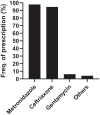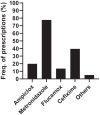Prevalence and factors associated with surgical site infections among mothers after cesarean section at Mbarara Regional Referral Hospital, Uganda: an observational retrospective study
- PMID: 39398974
- PMCID: PMC11468585
- DOI: 10.1177/20499361241286838
Prevalence and factors associated with surgical site infections among mothers after cesarean section at Mbarara Regional Referral Hospital, Uganda: an observational retrospective study
Abstract
Background: The risk of infection following cesarean delivery is 5-20 times higher than that following normal delivery, contributing to 10% of pregnancy-related mortality. In 2019, Mbarara Regional Referral Hospital (MRRH) performed cesarean section for 40% of deliveries, surpassing the WHO's recommended 15%-20%. The availability and provision of effective prophylactic antibiotics are crucial in preventing surgical site infections (SSIs).
Objectives: To determine the prevalence and predictors of SSIs among mothers after cesarean section, length of hospital stay, and antibiotic use at MRRH.
Design: This was an observational retrospective study conducted in the maternity ward of the MRRH.
Methods: Data on the diagnosis of SSI, length of hospital stay, and antibiotic use were extracted and entered into EpiData software version 3.1 and analyzed using STATA version 15. We conducted logistic regression analysis to identify factors independently associated with SSIs. We also compared the length of hospital stay.
Results: The prevalence of post-cesarean SSIs was 7.9% (95% CI: 6.3%-9.9%). Mothers aged 25 years and younger were less likely to develop SSIs (adjusted odds ratio (aOR): 0.53, 95% CI: 0.30-0.93; p = 0.027). Those with more than six pregnancies were more likely to develop SSIs (aOR: 3.4; 95% CI: 1.35-8.58; p = 0.009). The median length of stay was 8 days for mothers who developed an SSI (interquartile range (IQR): 5, 16) and 3 (IQR: 3, 4) days for those who did not (p < 0.001). Prophylactic antibiotics were prescribed to 83.4% of the women (95% CI: 80.7-85.8). Ampicillin (88.2%) was the most prescribed prophylactic antibiotic, and metronidazole was the most prescribed postoperatively (97.8%) and at discharge (77.6%).
Conclusion: The current prevalence of post-cesarean SSIs is higher in Uganda than in developed countries. Older age and having had more than six pregnancies are independent predictors of SSIs, and post-cesarean SSI significantly prolonged hospital stay.
Keywords: Cesarean section; antibiotic use; hospital stay; prevalence; surgical site infections.
© The Author(s), 2024.
Figures





Similar articles
-
Epidemiology of surgical site infections post-cesarean section in Africa: a comprehensive systematic review and meta-analysis.BMC Pregnancy Childbirth. 2025 Apr 22;25(1):465. doi: 10.1186/s12884-025-07526-y. BMC Pregnancy Childbirth. 2025. PMID: 40264037 Free PMC article.
-
Effectiveness of preoperative bath using chloroxylenol antiseptic soap on the incidence of post emergency cesarean section surgical site infection at Mbarara Regional Referral hospital, Uganda: a randomized controlled trial.Pan Afr Med J. 2022 Feb 2;41:92. doi: 10.11604/pamj.2022.41.92.23687. eCollection 2022. Pan Afr Med J. 2022. PMID: 35465375 Free PMC article. Clinical Trial.
-
Magnitude and factors associated with surgical site infection among mothers underwent cesarean delivery in Nekemte town public hospitals, western Ethiopia.PLoS One. 2021 Apr 27;16(4):e0250736. doi: 10.1371/journal.pone.0250736. eCollection 2021. PLoS One. 2021. PMID: 33905428 Free PMC article.
-
Maternal factors associated with early-onset neonatal sepsis among caesarean-delivered babies at Mbarara Regional Referral Hospital, Uganda: a case-control study.BMC Pregnancy Childbirth. 2024 Oct 28;24(1):707. doi: 10.1186/s12884-024-06903-3. BMC Pregnancy Childbirth. 2024. PMID: 39468517 Free PMC article.
-
Surgical site infection following cesarean section and its predictors in Ethiopia: A systematic review and meta-analysis.PLoS One. 2024 Mar 21;19(3):e0296767. doi: 10.1371/journal.pone.0296767. eCollection 2024. PLoS One. 2024. PMID: 38512861 Free PMC article.
Cited by
-
Length of hospital stay and its associated factors among women who gave birth by cesarean section in general hospitals of Sidama region, Ethiopia.PLOS Glob Public Health. 2025 Jun 5;5(6):e0004582. doi: 10.1371/journal.pgph.0004582. eCollection 2025. PLOS Glob Public Health. 2025. PMID: 40471883 Free PMC article.
-
Epidemiology of surgical site infections post-cesarean section in Africa: a comprehensive systematic review and meta-analysis.BMC Pregnancy Childbirth. 2025 Apr 22;25(1):465. doi: 10.1186/s12884-025-07526-y. BMC Pregnancy Childbirth. 2025. PMID: 40264037 Free PMC article.
References
-
- Smyth E, Emmerson A. Surgical site infection surveillance. J Hosp Infect 2000; 45: 173–184. - PubMed
LinkOut - more resources
Full Text Sources

